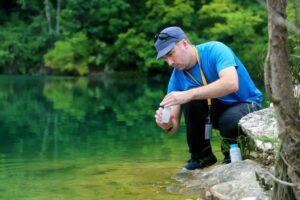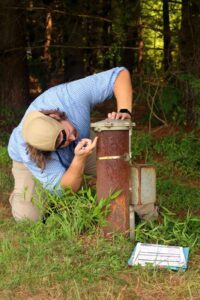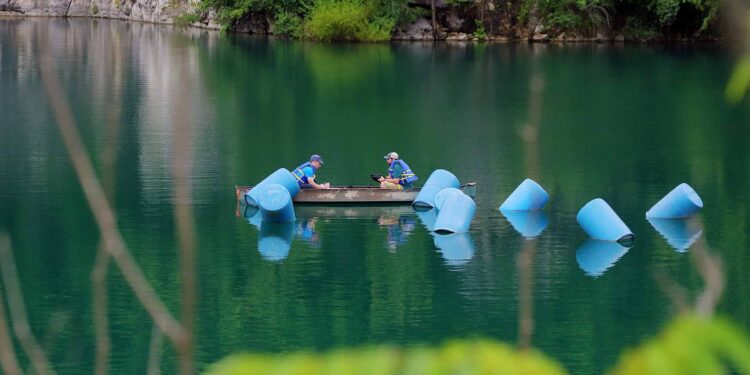What’s in your glass? Safe water is a county priority, but it’s residents’ job, too
by Lisa Moody Breslin – photography by Nikola Tzenov
My hot water heater needs to be replaced again.”
“My dishes don’t come clean.”
“I can’t make ice cubes.”
Welcome to the calls that roll in to local and state employees, plumbers and water treatment companies.
“My water smells like a swimming pool.”
“I have a white residue [or red stains or blue stains] around my faucets and drains.”
“My water tastes awful.”
These complaints represent some well-known and vigorously monitored manifestations of contaminants in Carroll County drinking water.
From hard water (white residue), to water with a high iron content (red stains), corroding copper plumbing (blue) and high chloride levels (failed appliances, salty tasting water), contaminants in local water are a force that a team of experts reckon with — and lose sleep about — all the time.
An important bottom line: “The water is safe to drink,” said Bret D. Grossnickle, Westminster’s superintendent of water treatment systems.

Many contaminants are naturally occurring. Most don’t pose a health risk and are easily treatable. Other contaminants could pose a hazard. For instance, long-term exposure to high nitrate levels is linked to thyroid disease, colon cancer, and birth defects, according to information published by the World Health Organization.
While Grossnickle, and many others who monitor local water, confirm that by all federal and state standards local municipal water is safe to drink, there are unregulated contaminants and other unknowns that concern them.
Municipalities are tasked with providing water with nitrate levels (and levels of all other federally regulated contaminants) below the federal maximum. Private well owners, on the other hand, must assess and monitor their own water quality.
A former Union Bridge council member and mayor, and currently a member of that town’s Planning and Zoning Council, Grossnickle has been at the helm of watching the quality of Carroll’s drinking water for more than 35 years.
He works closely with Zachary Neal, a hydrogeologist with the Carroll County Bureau of Resource Management, and Richard Brace, the Carroll County Health Department’s water quality supervisor.
Each municipality in Carroll has its own water system, with the exception of Sykesville/Eldersburg, which is part of the Freedom District and is managed by the county. The city of Westminster owns and operates two water treatment systems: the Cranberry water system, which is considered state-of-the-art, and the Wakefield Valley system. Over 70 percent of the city’s water needs are met through the Cranberry treatment plant. In addition, the city has 12 wells.
Digging deeper
To understand water quality and potential challenges, Neal said, it’s important to understand both the geology of the region as well as the water supply’s proximity to sources of potential contamination.
Westminster’s public drinking water comes from both surface water and groundwater sources. Neal said the county’s unique geology, combined with the region’s agricultural focus, heavily influences water quality.
“Groundwater originating from non-carbonate rocks tends to be naturally acidic; groundwater in carbonate rocks tends to have greater hardness, resulting in potential scale buildup in heated water,” he said. “In rural portions of the county, agricultural practices may lead to higher nitrate concentration in some water supply sources due to fertilizer usage and animal waste runoff.”
“Hard water, high nitrates and frequent hot water heater replacements are some of the top calls I get from homeowners and real estate agents, said Kevin Nottingham, CEO of First Class Mechanical, a Westminster-based construction and building maintenance company.
Both private well water and public water present distinct challenges and contaminants, said Chuck Mooshian, who runs Fountain Valley Analytical Laboratory, Inc. in Taneytown. The lab has provided sampling and water analysis since 1986.
Like Grossnickle, Chuck Mooshian tests and shares results without having a product to sell, which is an important consideration as residents do their research.
“No one can sit back and say, ‘I have city water, I’m fine,’ or ‘I’ve got a sound well, no worries,’” said Mooshian.
Rather than sit back, local experts encourage residents to sit up, do their drinking water homework and help manage contaminants.
“Maintaining the septic system, properly disposing of waste, properly applying pesticides, herbicides, and fertilizers” are some ways residents can help, Neal said.
WELL MAINTENANCE
Both well water and public water have distinct challenges and drawbacks. That means no one can sit back and say, “I have city water, I’m fine,” or “I’ve got a sound well, no worries.”
Rather than sit back, local experts encourage residents to sit up, do their drinking water homework and help manage contaminants.
“If you are not paying a water bill, save a comparable amount for well maintenance,” said Richard Brace, Water Quality Supervisor, Carroll County Bureau of Environmental Health. “New well pump, pressure tanks, seals — you should just pretend you have a water bill.”
Well owners should also:
- Find out how and when your well was drilled.
- Most wells should have a well tag with “CL” followed by six numbers. With that tag information, request a well completion report from the county Health Department.
- Several well standards changed in the 1970s; for example, grouting standards and casing standards changed. Folks with hand-dug wells with 20 feet of casing can run into trouble.
- Check your well caps to ensure that there is a complete, sanitary seal.
- Protect the well head. Keep as many contaminants away as possible.
- Don’t use weed killer near the well head.
- Be aware of road salt runoff.
- Check the structural integrity of the well.
- Check and, if necessary, service well equipment annually.
- Have an annual bacteria test. Approximate cost: $85.

Setting the standard
The Environmental Protection Agency establishes what is tested and sets maximum limits for various contaminants.
EPA standards are the testing bible for the city of Westminster, the county Health Department, the Maryland Department of Environment, Fountain Valley Lab and companies that test local water and offer ways to mitigate contaminants.
Municipalities post water test results on their websites, most notably in an annual Consumer Confidence Report. Residents can find the address for the report on their water bills, Grossnickle said.
“We have Fountain Valley do 44 tests for coliform monthly and chlorine disinfection byproducts quarterly. Tests for nitrates, metals, fluoride, pesticides, herbicides, gases and oils, in places once a year, sometimes twice a year,” Grossnickle said. “We test monthly, quarterly, annually, over longer spans and for a lot of other things, based on what federal regulations stipulate.”
There are a few things to keep in mind when it comes to test results. Many standards have not been updated in more than 20 years, some more than 40. In addition, there are many potential contaminants that remain unregulated and untested, according to local, state and national researchers.
To address this situation, the EPA created the Unregulated Contaminant Monitoring Rule and has tested and is currently testing a number of unregulated contaminants, Neal said.
Concerned about outdated standards for drinking water and untested contaminants, a Washington DC-based nonprofit called Environmental Working Group (EWG), established its own set of health guideline standards. EWG, according to its website, is an activist group that specializes in research and advocacy in the areas of agricultural subsidies, toxic chemicals, drinking water pollutants, and corporate accountability.
EWG’s report on local water sources suggests many contaminants, by their guidelines, exceed safe limits, although many of them remain within the EPA’s limits. For example, EWG reports that haloacetic acids (which can be created as a byproduct of water chlorination) in local water measured 435 times higher than EWG health guidelines, yet the level was below the EPA’s legal threshold.
The potential effect of long-term exposure to many of these contaminants includes cancer, according to Tasha Stoiber, senior scientist for the EWG. She noted that contaminants become cancer risks over long periods of exposure and that there are a lot of things people can do to limit exposure, including installing home water filters or systems and pushing for more stringent guidelines and federal funding.
Local water officials agree that we need to be vigilant about water safety, but they don’t want residents to be alarmed by what they hear from groups like EWG.
“I can’t say that their [EWG] numbers don’t matter,” said Brace. “We follow safe drinking water standards set at the federal level. Research continues, but changes are slow.”
Grossnickle added, “Trust me, we all want zero readings. It’s just not that simple. There are times when a treatment for one contaminant brings others that are more aggressive.
Neal said that not every contaminant and reading is a universal problem.
“Remember, some secondary concerns are natural and widespread. Others, particularly for primary standards, have identifiable sources of origin and may impact only a small area or subset of people.”

Keeping it clean
In addition to testing, the county has a rigorous cleaning regiment for the 12 wells that supply municipalities and homes in the county.
“We clean and sanitize the water towers; in fact, we just finished Pleasant Valley in mid-August,” said Nottingham. “We drained the tower, sanitized it and refilled it. We also work on the pumps inside and outside the towers for the county.”
One of the top well-water issues dogging municipalities and the county are the effects of road salt runoff.
“Road salt percolates down and can cause high chlorides in wells,” said Brace. “When I get a call about dishwashers or hot water heaters, I ask for an address first because a lot of road salt ends up in wells that are at the end of a cul-de-sac.”
The state is taking action to solve this problem, reducing its use of road salt and working with residents and the county to mitigate specific instances of contamination, which sometimes involves drilling a new well.
“It’s not a widespread problem everywhere. There are very specific circumstances that lead to certain wells having elevated chloride concentrations. In some cases, it may be tied to road salt,” said Neal. “We’ve also seen instances where neighboring water treatment devices [water softeners] are responsible for elevated chloride in downgradient wells. The exact sources aren’t always easy to identify.”
Watching for new threats
Local experts keep an eye on issues in other parts of the nation in order to be as proactive as possible.
PFAS chemicals, for example, are a class of thousands of persistent man-made substances that have been found in soil, water, and in some cases air near specific sources across the nation. While PFAS have been receiving a lot of recent attention at the national level, Neal said that they are still pretty new in terms of regulators understanding how to find and treat the chemicals.
According to EWG, “PFAS is not designated as hazardous substances under the federal Superfund law; and, there is no national drinking water standard for PFAS in tap water.” EWG contends that the use of PFAS in household products should be banned, there should be a moratorium on the approval of new PFAS and industries should expand PFAS reporting.
PFAS chemicals are used in a variety of everyday products, such as cosmetics and stain-resistant materials, as well as in fire suppression foam.
Earlier this year MDE released a report that noted that one of Hampstead’s wells and one of Westminster’s wells had PFAS levels in excess of the health advisory. As a precautionary action, both municipalities removed the affected wells from service.
According to Grossnickle and Neal, both municipalities turned off the wells that tested at high levels; residents were notified and have not been affected. While costly, both municipalities continue to assess treatment for PFAS in those wells.

Finding solutions
Hard water, acidic water, water with bacteria, or high nitrates — for every problem, there is a solution. Solutions run from installing a simple filter under the kitchen sink to whole-house treatments that can run from $10,000 to $30,000. Under some circumstances, drilling a replacement well may be appropriate.
Rick Roos and his wife, Georgina, own R&G Water Systems, Inc. in Hampstead. Rick said that a filter installed at “point of use,” under the kitchen sink for example, might run in the $200-$300 range.
According to the R&G Water System website, homeowners relying on well water are responsible for managing and maintaining their water quality: “While it was inspected and declared safe when it was drilled, over time it may become contaminated.” The site also notes that while city water is monitored per EPA standards, as it leaves the treatment facility it can pick up contaminants from outdated plumbing systems on its way to households.
R&G and other local water companies offer water analysis services that test for a range of mineral content and common contaminants. The most important message coming from experts is that residents should be proactive in understanding where their water comes from and the health of their water.
The solutions, the issues, wells versus public water — “It’s tough to understand it all,” Grossnickle agreed. “But it’s important that everyone does.”













